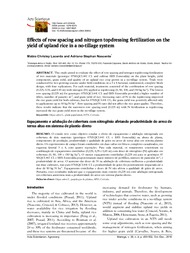Effects of row spacing and nitrogen topdressing fertilization on the yield of upland rice in a no-tillage system.
Effects of row spacing and nitrogen topdressing fertilization on the yield of upland rice in a no-tillage system.
Autoria: LACERDA, M. C.; NASCENTE, A. S.
Resumo: This study aimed to evaluate the effect of row spacing and nitrogen topdressing fertilization of two materials (genotype 07SEQCL441 CL and cultivar BRS Esmeralda) on the plant height, yield components, grain yield, and quality of an upland rice crop grown in a no-tillage system. Trials were conducted for two growing seasons under field conditions in a 3 x 4 factorial, randomized, complete block design, with four replications. For each material, treatments consisted of the combination of row spacing (0.225, 0.35, and 0.45 m) with nitrogen (N) applied as topdressing (0, 50, 100, and 150 kg ha-1). The lowest row spacing (0.225 m) for genotypes 07SEQCL441 CL and BRS Esmeralda provided a higher number of tillers, number of panicles m-2, and grain yield of rice. Increasing rates of N in the topdressing improved the rice grain yield for both cultivars, but for 07SEQCL441 CL, the grain yield was positively affected only to applications up to 50 kg N ha-1. Row spacing and N rates did not affect the rice grain quality. Therefore, these results indicate that the narrowest row spacing used (0.225 m) with N fertilization as topdressing increased the rice grain yield most in the no-tillage system.
Ano de publicação: 2016
Tipo de publicação: Artigo de periódico
Unidade: Embrapa Arroz e Feijão
Palavras-chave: Arroz, Cerrado, Nitrogênio, Oryza sativa, Plantio direto, População de planta
Observações
1 - Por padrão são exibidas publicações dos últimos 20 anos. Para encontrar publicações mais antigas, configure o filtro ano de publicação, colocando o ano a partir do qual você deseja encontrar publicações. O filtro está na coluna da esquerda na busca acima.
2 - Para ler algumas publicações da Embrapa (apenas as que estão em formato ePub), é necessário ter, no celular ou computador, um desses softwares gratuitos. Sistemas Android: Google Play Livros; IOS: iBooks; Windows e Linux: software Calibre.
Acesse outras publicações
Acesse a Base de Dados da Pesquisa Agropecuária (BDPA) para consultar o acervo completo das bibliotecas da Embrapa.

